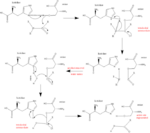Sandbox Reserved 918
From Proteopedia
| This Sandbox is Reserved from Jan 06, 2014, through Aug 22, 2014 for use by the Biochemistry II class at the Butler University at Indianapolis, IN USA taught by R. Jeremy Johnson. This reservation includes Sandbox Reserved 911 through Sandbox Reserved 922. |
To get started:
More help: Help:Editing |
Contents |
Dipeptidyl Peptidase IV
Introduction
Dipeptidyl Peptidase IV (commonly abbreviated as DPP IV) is a regulatory protease and binding glycoprotein that carries out numerous functions in humans making it a prime candidate for medicinal and pharmaceutical research. DPP IV, discovered by V.K. Hopsu-Havu and G.G. Glenner in homogenized rat liver tissue[1], was originally believed to serve a specific role in breaking 2-Naphthylamine off of Gly-Pro-2-napthylamide, hence its original name glycylproline napthylamidase. However, further research into the specificity of DPP IV eventually showed that it serves a more generic function as a hydrolase (a serine exopeptidase), breaking N-terminal Xaa-Pro bonds (though it can also catalyze alanine bonds). DPP IV is the founding member of the DPP-IV and/or structure homologue (DASH) family, who all share this serine protease catalysis of post-proline peptide bonds. [2] These penultimate prolines of the N-terminus are known for their ability to resist attacks from most proteases and also induce a conformational change of their respective proteins. Also, DPP IV serves as a binding glycoprotein on the membrane of cells, binding ligands such as adenosine deaminase with high affinity.[3] Though this interaction has no known significance as of yet, DPP IV and its ability to catalyze N-terminal prolines gives it a unique specificity and target for pharmaceutical companies to take advantage of. [1]
Structure
| |||||||||||
Medical Relevancy
DPP IV is found in diverse tissue types and is involved in various biological functions. The activity of DPP IV has been studied in fields like immunology, endocrinology, and the biology of cancers. [3] The ability of DPP IV to inactivate incretins glucagon-like-peptide-1 (GLP-1) and glucose-dependent insulinotropic polypeptide (GIP) have made it a well-studied protein because of its potential as a drug target for the treatment of Type II Diabetes. GLP-1 and GIP promote glucose uptake, decrease the gastric emptying rate and inhibit glucagon secretion. These actions are all desired when it comes to treating Type II diabetes, but the problem is that DPP IV inactivates GLP-1 and GIP rapidly (the half-lives of GLP-1 and GIP are less than two minutes). [4] DPP IV inhibitors prevent DPP IV from inactivating GLP-1 and GIP, which results in improved glucose tolerance and pancreatic islet cell function, and a decrease in blood glucose levels. The decrease in blood glucose is associated with increased levels of active circulating GLP-1 and a reduction of glucagon. [5]
References
- ↑ 1.0 1.1 Mentlein R. Dipeptidyl-peptidase IV (CD26)--role in the inactivation of regulatory peptides. Regul Pept. 1999 Nov 30;85(1):9-24. PMID:10588446
- ↑ Lankas GR, Leiting B, Roy RS, Eiermann GJ, Beconi MG, Biftu T, Chan CC, Edmondson S, Feeney WP, He H, Ippolito DE, Kim D, Lyons KA, Ok HO, Patel RA, Petrov AN, Pryor KA, Qian X, Reigle L, Woods A, Wu JK, Zaller D, Zhang X, Zhu L, Weber AE, Thornberry NA. Dipeptidyl peptidase IV inhibition for the treatment of type 2 diabetes: potential importance of selectivity over dipeptidyl peptidases 8 and 9. Diabetes. 2005 Oct;54(10):2988-94. PMID:16186403
- ↑ 3.0 3.1 3.2 3.3 3.4 3.5 3.6 Gorrell MD. Dipeptidyl peptidase IV and related enzymes in cell biology and liver disorders. Clin Sci (Lond). 2005 Apr;108(4):277-92. PMID:15584901 doi:http://dx.doi.org/10.1042/CS20040302
- ↑ Green BD, Flatt PR, Bailey CJ. Dipeptidyl peptidase IV (DPP IV) inhibitors: A newly emerging drug class for the treatment of type 2 diabetes. Diab Vasc Dis Res. 2006 Dec;3(3):159-65. PMID:17160910 doi:http://dx.doi.org/10.3132/dvdr.2006.024
- ↑ Lambeir AM, Durinx C, Scharpe S, De Meester I. Dipeptidyl-peptidase IV from bench to bedside: an update on structural properties, functions, and clinical aspects of the enzyme DPP IV. Crit Rev Clin Lab Sci. 2003 Jun;40(3):209-94. PMID:12892317 doi:10.1080/713609354

